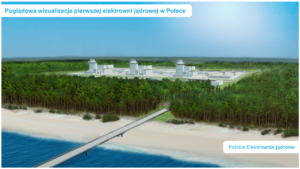– We hope that joint position of the EC and USA will not allow Gazprom to complete Nord Stream 2. Poland and Ukraine could get significant synergies from deeper integration of their gas markets – states Serhiy Makogon, Ukrainian GTS Operator CEO.
How NS2 influenced gas transit volume in Ukraine? How it was influenced by NS2 delay? What are the possible changes in future?
Construction of NS1 resulted in significant losses of transit for the Ukrainian GTS. Turk stream already resulted in reduction of transit via Ukraine by 15 bcm, construction of Turk Stream – 2 will result in additional reduction of transit via Ukraine by 15 bcm.
Construction of NS2 will allow Russia to fully bypass Ukraine and completely redirect gas flows. Such situation will result not just in significant revenue losses for Ukraine, but also it would significantly increase risks of aggressive actions of Russia towards Ukraine, including military escalation.
We hope that joint position of the EC and USA will not allow Gazprom to complete NS-2. Construction of NS2 does not create any alternative supply source for Ukraine; it is just excessive transportation route of the same Russia gas.
How the five year transit contract with Gazprom influences Ukrainian GTS stability?
The new contract with Gazprom will bring about 7 bln USD to the Ukrainian TSO, which will be used on GTS modernization and optimization for the new market demand of 40 bcm of transit and 30 bcm of local transportation. This new transit contract has a “ship-or-pay” clause that ensures stable revenue flow to the Ukrainian TSO.
What about Gazprom unlawful influence over gas infrastructure signalled by EC – is it present in Ukraine in spite of gas reform?
Expiration of the legacy contract with Gazprom allowed us to fully unblock our infrastructure at the Western borders. The Ukrainian TSO was able to sign direct interconnection agreements with neighboring European TSOs and now fully in charge of its own infrastructure. Representatives of Gazprom are not present at the our gas metering stating anymore. I can say that now transit of Russian gas via Ukraine is fully aligned with Ukrainian and EU energy law.
However, there are still several legacy issues in EU countries that need to be addressed and resolved. In particular, the legacy booking contract between Gazprom in Slovakia. There is significant infrastructure in Slovakia, which is booked by Gazprom, but not used anymore. We insists, that lose-or-use principle shall be used and capacities should be offered to other shippers, in particular for capacities from Austria to Ukraine via Slovakia. Now only 27 mcm per day of firm capacities is offered by Eustream towards Ukraine, we think that they could be easily increased up to 80-100 mcm per day just my amending the legacy contracts. Those legacy contracts limits possibility of the Ukrainian TSO to utilize its own infrastructure by independent shippers, which from our point of view should be addressed by European and Slovakian regulators and competition authorities.
How gas reform in Ukraine changed the market?
The Ukrainian market has changed significantly since the Gas Market reform in 2015. There are about 250 active gas traders in Ukraine and 80 of them do import from EU to Ukraine independently. The market share of former incumbent Naftogaz at the deregulated segment of the gas market decreased to the level of 5-8%. About 45 local private gas produces sell about 5 bcm of gas at market terms to local trades. Ukrainian Energy Exchange constantly increases the volumes of trades. Daily balancing was introduced last year, which brought additional liquidity to the market and facilitated trading. Customs warehouse regime was introduced in the Ukrainian gas storages, which allowed international traders to store gas there without any customs fees and VAT up to 3 years. This allowed to attract about 2.4 bcm of gas of non-resident traders to Ukrainian storages last year.
Expiration of the legacy transit contract with Gazprom allowed the new TSO of Ukraine to sign direct interconnection agreements with neighboring EU TSOs and implement new products to simplify operations for shippers. First, possibility of virtual reverse flow was implemented. The next step is combining physical interconnection points into one single virtual interconnection point as prescribed by CAM NC.
In May 2020 we expect opening of the gas market for households and district heating companies. It would additionally boost liquidity of the market.
What are the prospects of Gas Interconnector Poland-Ukraine?
I believe that Poland and Ukraine could get significant synergies from deeper integration of their gas markets, especially taking into consideration Polish LNG terminal and Baltic pipeline and Ukrainian GTS and powerful storages. We already have two pipelines that connect our countries that can be used for transporting gas between countries. From Ukrainian side we have invested about 30 mln USD last years in rehabilitation of those pipelines as a result we are ready to offtake from Polish GTS up to 6.6 bcm of gas per year. Unfortunately, because of several bottlenecks in Polish system only about 2 bcm/year can be physically delivered to the Ukrainian border from Polish side. As we know, after completion of pipeline construction near Tworzhen and reconstruction of CS Strakochina those bottlenecks will be eliminated by 2021. Meanwhile gas swaps can be used for gas deliveries from the Polish LNG terminal to Ukraine.
Starting from 1 January 2020 the following capacities in direction PL-UA are available: IP Drozdovichi – 9 mcm/d and IP Hermanowice – 6,4 mcm/d. At the same time, starting from beginning of the year, on average 2.6 mcm/d were imported through IP Drozdovichi, and 0,7 mcm/d were imported through IP Hermanowice. This means that 6.4 mcm/d on IP Drozdovichi and 5.7 mcm/d on IP Hermanowice still remain unused and are available to market participants for delivering gas from Poland to Ukraine. Thus, there is enough available capacities at the border for shippers interested in supplying gas to Ukraine.
In order to assess future market demand for capacities at the border, we plan to run new a Capacity Increase process. We are in constant dialogue with our colleagues from Gaz-Systems in order to quickly react on demand of the market.
Is Ukraine Gas Operator interested in European funding? What are the prospects of cooperation inside Energy Community?
Ukraine is crucially important for ensuring energy security of Europe, in particular Eastern Europe. Our developed GTS and powerful underground gas storages have been securing gas supplies to EU for decades. Even now after completion of Nord Stream -1 and Turk Stream Ukraine plays an important transit role.
Ukrainian GTS is underutilized thus in our next TYNDP we will focus mainly optimization of the system and liquidating excessive assets. The new transit contract with Gazprom clearly defines the expected volumes of transit, so we use those volumes of 40 bcm per year for our development plans. In case Russian or EU shippers decide to book additional transit capacities, we are ready to amend our plans, but we definitely cannot support expensive excessive infrastructure without long-term booking contracts.
According to our TYNDP we plan to invest about 1,5 bln EURO into our capital investment project during next 10 years. We consider different sources of funding. Unfortunately, EU funding available only for PCI projects, which are only for EU members. However, we think that several projects that we have can bring significant value for both EU and Ukraine: a new interconnector between Ukraine and Romania, Interconnector between Poland and Ukraine, creating firm transportation capacities towards Ukraine in Hungary and Slovakia. We will continue working with the EC on supporting those projects.
We pay significant attention to development of cross-border gas trade in the Energy Community and Eastern Europe. This year we introduced ‘short-haul’ transmission services which allow to transport gas via Ukraine between neighboring countries (PL, SK, HU, RO) at very discounted tariffs. For example, now gas can be easily delivered from Poland to Hungary via Ukraine. This service is highly appreciated by market participants and we started such deliveries already.
Interview by Wojciech Jakóbik








